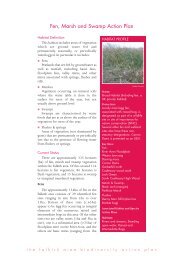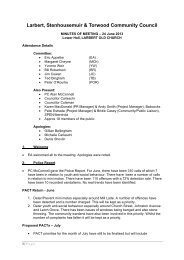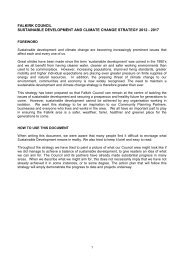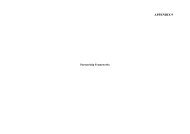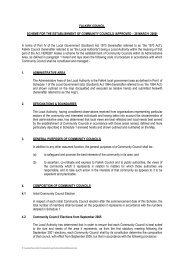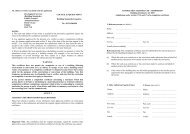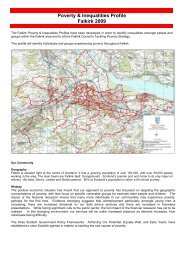2011/2012 audited annual accounts - Falkirk Council
2011/2012 audited annual accounts - Falkirk Council
2011/2012 audited annual accounts - Falkirk Council
You also want an ePaper? Increase the reach of your titles
YUMPU automatically turns print PDFs into web optimized ePapers that Google loves.
The <strong>Council</strong> as Lessee<br />
Finance Leases<br />
FALKIRK COUNCIL<br />
Property, plant and equipment held under finance leases is recognised on the Balance Sheet at the<br />
commencement of the lease at its fair value measured at the lease’s inception (or the present value of the<br />
minimum lease payments, if lower). The asset recognised is matched by a liability for the obligation to pay the<br />
lessor. Initial direct costs of the <strong>Council</strong> are added to the carrying amount of the asset. Premiums paid on entry<br />
into a lease are applied to writing down the lease liability. Contingent rents are charged to expenses in the<br />
periods in which they are incurred.<br />
Lease payments are apportioned between:<br />
• A charge for the acquisition of the interest in the property, plant or equipment – applied to write down the<br />
lease liability and<br />
• A finance charge - debited to the Financing and Investment Income and Expenditure line in the<br />
Comprehensive Income & Expenditure Statement<br />
Property, plant and equipment recognised under finance leases is accounted for using the policies applied<br />
generally to such assets, subject to depreciation being charged over the lease term if this is shorter than the<br />
asset’s estimated useful life (where ownership of the asset does not transfer to the <strong>Council</strong> at the end of the lease<br />
period).<br />
The <strong>Council</strong> is not required to raise council tax to cover depreciation or revaluation and impairment losses<br />
arising on leased assets. Instead, a prudent <strong>annual</strong> contribution is made from revenue funds towards the deemed<br />
capital investment in accordance with statutory requirements. Depreciation and impairment losses are therefore<br />
substituted by a revenue contribution in the General Fund Balance, by way of an adjusting transaction with the<br />
Capital Adjustment Account in the Movement in Reserves Statement for the difference between the two.<br />
Operating Leases<br />
Rentals paid under operating leases are charged to the Comprehensive Income & Expenditure Statement as an<br />
expense of the services benefitting from use of the leased property, plant or equipment. Where material, charges<br />
are made on a straight-line basis over the life of the lease, even if this does not match the pattern of payments<br />
(e.g. there is a rent-free period at the commencement of the lease).<br />
The <strong>Council</strong> as Lessor<br />
Finance Leases<br />
Where the <strong>Council</strong> grants a finance lease over a property or an item of plant or equipment, the relevant asset is<br />
written out of the Balance Sheet as a disposal. At the commencement of the lease, the carrying amount of the<br />
asset in the Balance Sheet (whether Property, Plant and Equipment or Assets Held for Sale) is written off to the<br />
Other Operating Expenditure line in the Comprehensive Income & Expenditure Statement as part of the gain or<br />
loss on disposal. A gain, representing the <strong>Council</strong>’s net investment in the lease, is credited to the same line in the<br />
Comprehensive Income & Expenditure Statement also as part of the gain or loss on disposal (i.e. netted off<br />
against the carrying value of the asset at the time of disposal), matched by a Debtor in the Balance Sheet.<br />
Lease rentals receivable are apportioned between:<br />
• A capital receipt for the disposal of the asset – applied to write down the Debtor (together with any premiums<br />
received), and<br />
• Finance income - credited to the Financing and Investment Income and Expenditure line in the<br />
Comprehensive Income & Expenditure Statement<br />
The gain credited to the Comprehensive Income & Expenditure Statement on disposal is not permitted by statute<br />
to increase the General Fund Balance and will be required to be treated as a capital receipt. Where a premium has<br />
been received, this is posted out of the General Fund Balance to the Capital Receipts Reserve in the Movement<br />
in Reserves Statement. Where the amount due in relation to the lease asset is to be settled by the payment of<br />
rentals in future financial years, the amount relating to the disposal (initial debtor) value is credited to the Capital<br />
Receipts Reserve immediately (and not via the Deferred Capital Receipts Reserve). When the future rentals are<br />
received, the element for the capital receipt for the disposal of the asset is used to write down the Debtor.<br />
21



